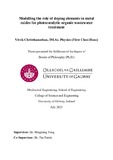| dc.description.abstract | The thesis presents research on visible light-harvesting photocatalysts for
wastewater treatment, with a specific focus on the design of an advanced
photocatalyst capable of efficiently generating electron-hole (e-
-h+) pairs and
harnessing a broader range of the visible light spectrum. To achieve this, first principles computational modelling is employed to quantify the impact of chemical
modifications on the structural and electronic properties of the photocatalysts.
The primary focus of the thesis revolves around modelling the photocatalytic
degradation of methylene blue (MB) molecules using metal oxides. Notably, the
research encompasses the exploration of thin film metal oxide (MO) photocatalysts
through density functional theory (DFT) modelling, unravelling the intricate
processes of organic molecule adsorption and subsequent degradation
mechanisms. The successful modelling of undoped and Cu-doped CaWO4 thin
films serves as a pioneering milestone in this field. By comprehensively examining
the interactions of MB-loaded thin films, this research promises profound insights
into the photocatalytic mechanisms crucial for wastewater treatment techniques,
with significant implications for industries such as pharmaceuticals, cosmetics,
food, and energy harvesting.
In terms of structure, the thesis consists of eight chapters. Chapters 1–3 provide
the necessary background, the research aims and objectives, and an overview of
the modelling methods employed in the project. Chapters 4 and 5 delve into the
modelling of doping bulk metal oxides with transition metals (TMs). Chapter 6
focuses on the modelling of doping metal oxide thin films using metal ions.
Chapter 7 centres around the modelling of the interaction between methylene blue
and the metal oxide thin film. Lastly, Chapter 8 offers concluding remarks
summarising the key findings and implications of the research.
Chapter 1 is a general introduction to the thesis and the PhD project. Chapter 2 presents the aim, research questions and objectives of the project.
Chapter 3 presents the principles of density functional theory (DFT) and an
overview of its related applications. The general methodology used throughout the
thesis is given here.
Chapter 4 presents the computational modelling results of the effect of Zn2+
and La3+ ions on the photocatalytic properties of bulk anatase TiO2 regarding the
chemical modification of doping or co-doping the metal oxide. The chapter
interprets the impact of dopants (such as Zn2+ and La3+) in TiO2 such as the
electronic band structure, relative stability, and photocatalytic activities. The
optimal doping concentration was predicted. It was found that the Zn2+-La3+ co doped TiO2 system, which has a composition of 6.25 at.% Zn and 2.08 at.% La,
exhibit notable absorption activity within the visible light range of 400 to 540 nm.
This behaviour can be attributed to the limited influence of La-4f orbitals on the
band edge levels.
Chapter 5 presents the computational modelling results of the chemically
modified bulk CaWO4 that are doped using Cu2+ cations. The modelling results of
the photocatalytic properties of the modified bulk CaWO4 (e.g. absorption
spectra), thermostability, and electronic properties (such as density of states
(DOS), charge density difference (CDD), electronic band structure) are analysed
to understand how and why Cu2+ doping could have such influence.
Chapter 6 presents the computational modelling results of doping the CaWO4
thin film using Cu2+, focusing on the electronic and photocatalytic properties.
Interestingly, the CaWO4 thin film at the (101) exposed surface effectively
decreases the bandgap value by 0.39 eV when compared to the corresponding bulk
material.
Chapter 7 presents the computational modelling results of the interaction
between methylene blue (MB) and undoped and Cu-doped CaWO4 thin films, in
relation to the MB absorption and oxidation behaviour as well as the electronic
properties of the oxide. Moreover, to examine the electrochemical potential of the
thin-film, the adsorption of small molecules such as O2, H2, and H2O on the Ca terminated surface of CaWO4 was analyzed using the computational method. The
work on the adsorption of MB with various orientations on CaWO4 surface
revealed several new findings for the first time, including (i) the MB molecule
would react strongly to the surface of the oxide in the presence of Ca2+ ions due
to the charge transfer from the reduced surface to the oxidized molecule, (ii)
doping the (101) surface of CaWO4 thin film with a low concentration of Cu-cation
can effectively improve the oxidation of MB without compromising surface Ca's
reduction, and (iii) doping the (101) surface of CaWO4 thin film with a high
concentration of Cu2+ cation can inhibit MB oxidation while promoting surface
Ca2+'s partial oxidation on the CaWO4 thin film.
Chapter 8 presents the comprehensive conclusions of the project as well as
specific answers to the research questions. | en_IE |


